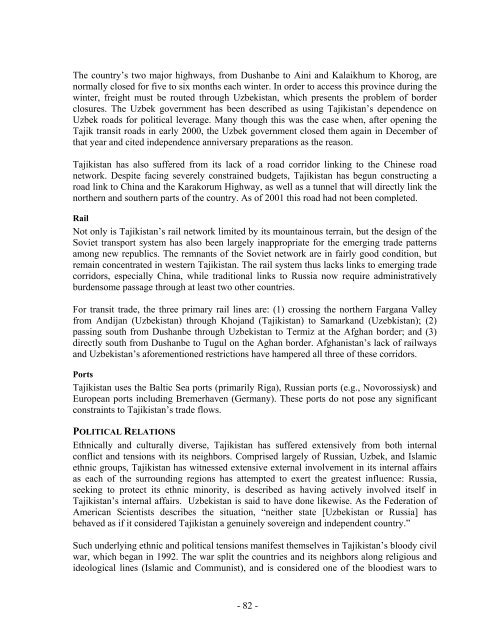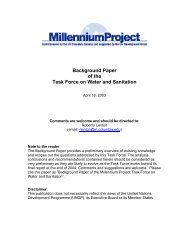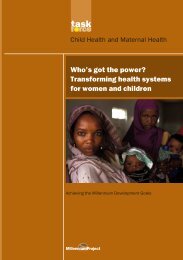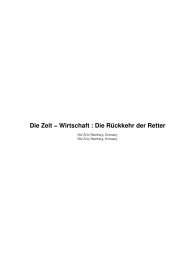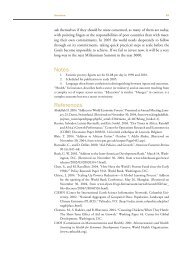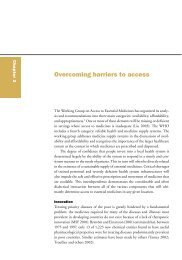the challenges facing landlocked developing countries: a case study ...
the challenges facing landlocked developing countries: a case study ...
the challenges facing landlocked developing countries: a case study ...
You also want an ePaper? Increase the reach of your titles
YUMPU automatically turns print PDFs into web optimized ePapers that Google loves.
The country’s two major highways, from Dushanbe to Aini and Kalaikhum to Khorog, are<br />
normally closed for five to six months each winter. In order to access this province during <strong>the</strong><br />
winter, freight must be routed through Uzbekistan, which presents <strong>the</strong> problem of border<br />
closures. The Uzbek government has been described as using Tajikistan’s dependence on<br />
Uzbek roads for political leverage. Many though this was <strong>the</strong> <strong>case</strong> when, after opening <strong>the</strong><br />
Tajik transit roads in early 2000, <strong>the</strong> Uzbek government closed <strong>the</strong>m again in December of<br />
that year and cited independence anniversary preparations as <strong>the</strong> reason.<br />
Tajikistan has also suffered from its lack of a road corridor linking to <strong>the</strong> Chinese road<br />
network. Despite <strong>facing</strong> severely constrained budgets, Tajikistan has begun constructing a<br />
road link to China and <strong>the</strong> Karakorum Highway, as well as a tunnel that will directly link <strong>the</strong><br />
nor<strong>the</strong>rn and sou<strong>the</strong>rn parts of <strong>the</strong> country. As of 2001 this road had not been completed.<br />
Rail<br />
Not only is Tajikistan’s rail network limited by its mountainous terrain, but <strong>the</strong> design of <strong>the</strong><br />
Soviet transport system has also been largely inappropriate for <strong>the</strong> emerging trade patterns<br />
among new republics. The remnants of <strong>the</strong> Soviet network are in fairly good condition, but<br />
remain concentrated in western Tajikistan. The rail system thus lacks links to emerging trade<br />
corridors, especially China, while traditional links to Russia now require administratively<br />
burdensome passage through at least two o<strong>the</strong>r <strong>countries</strong>.<br />
For transit trade, <strong>the</strong> three primary rail lines are: (1) crossing <strong>the</strong> nor<strong>the</strong>rn Fargana Valley<br />
from Andijan (Uzbekistan) through Khojand (Tajikistan) to Samarkand (Uzebkistan); (2)<br />
passing south from Dushanbe through Uzbekistan to Termiz at <strong>the</strong> Afghan border; and (3)<br />
directly south from Dushanbe to Tugul on <strong>the</strong> Aghan border. Afghanistan’s lack of railways<br />
and Uzbekistan’s aforementioned restrictions have hampered all three of <strong>the</strong>se corridors.<br />
Ports<br />
Tajikistan uses <strong>the</strong> Baltic Sea ports (primarily Riga), Russian ports (e.g., Novorossiysk) and<br />
European ports including Bremerhaven (Germany). These ports do not pose any significant<br />
constraints to Tajikistan’s trade flows.<br />
POLITICAL RELATIONS<br />
Ethnically and culturally diverse, Tajikistan has suffered extensively from both internal<br />
conflict and tensions with its neighbors. Comprised largely of Russian, Uzbek, and Islamic<br />
ethnic groups, Tajikistan has witnessed extensive external involvement in its internal affairs<br />
as each of <strong>the</strong> surrounding regions has attempted to exert <strong>the</strong> greatest influence: Russia,<br />
seeking to protect its ethnic minority, is described as having actively involved itself in<br />
Tajikistan’s internal affairs. Uzbekistan is said to have done likewise. As <strong>the</strong> Federation of<br />
American Scientists describes <strong>the</strong> situation, “nei<strong>the</strong>r state [Uzbekistan or Russia] has<br />
behaved as if it considered Tajikistan a genuinely sovereign and independent country.”<br />
Such underlying ethnic and political tensions manifest <strong>the</strong>mselves in Tajikistan’s bloody civil<br />
war, which began in 1992. The war split <strong>the</strong> <strong>countries</strong> and its neighbors along religious and<br />
ideological lines (Islamic and Communist), and is considered one of <strong>the</strong> bloodiest wars to<br />
- 82 -


